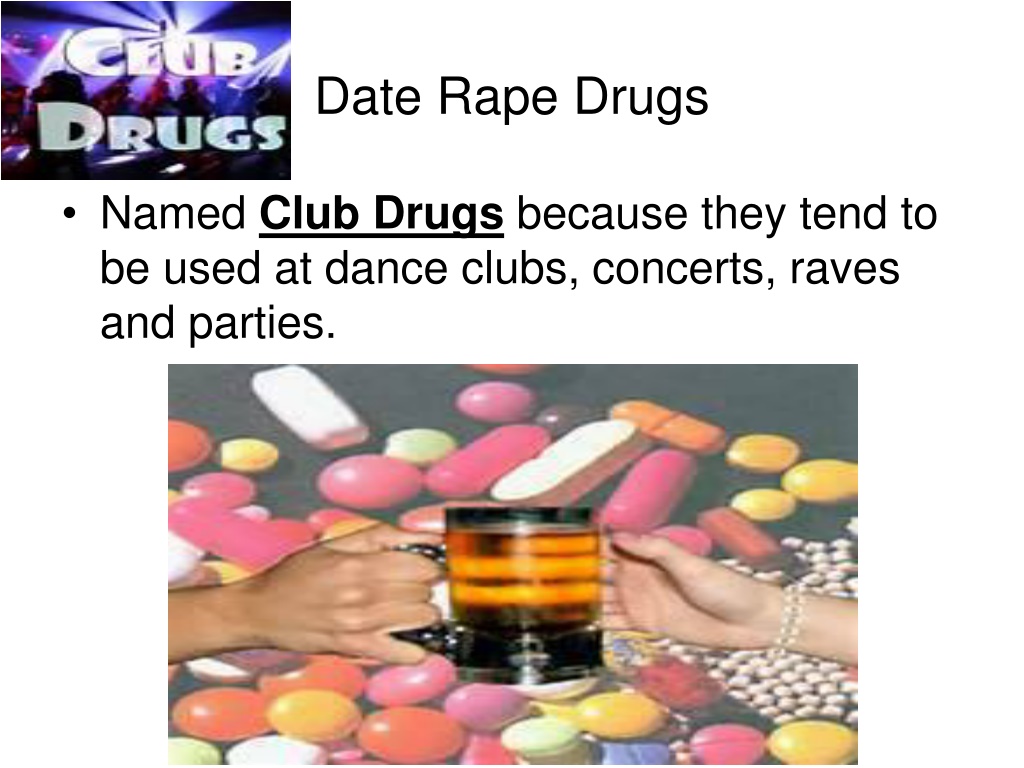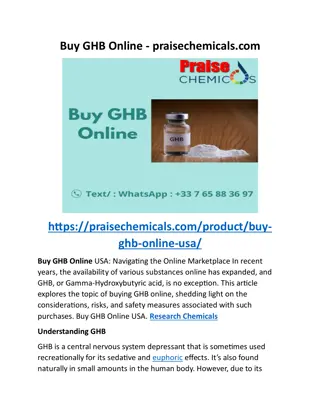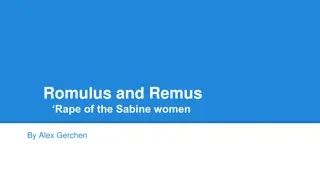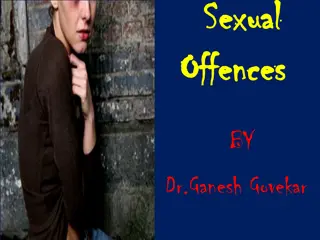Understanding Date Rape Drugs: Rohypnol and GHB
Date rape drugs, often referred to as club drugs, are commonly used at dance clubs, concerts, raves, and parties. Rohypnol, also known as Roofies, is a depressant drug prescribed in Europe for sleep and pre-surgery relaxation. It is orally taken in various colored pills, such as olive green or white. Short-term effects of Rohypnol include memory loss and impaired judgment, while long-term effects can be severe, leading to addiction, coma, and respiratory failure. GHB, or Gamma Hydroxybutyric Acid, acts as a depressant on the CNS and is colorless and odorless. This drug was banned in the US in 1990. Both drugs have harmful effects and should not be used for medical purposes.
Download Presentation

Please find below an Image/Link to download the presentation.
The content on the website is provided AS IS for your information and personal use only. It may not be sold, licensed, or shared on other websites without obtaining consent from the author. Download presentation by click this link. If you encounter any issues during the download, it is possible that the publisher has removed the file from their server.
E N D
Presentation Transcript
Date Rape Drugs Named Club Drugs because they tend to be used at dance clubs, concerts, raves and parties.
ROHYPNOL Row-Hip-Nole DEPRESSANT DRUG Hoffmann-LaRoche Company Official Name: Flunitrazepam Sedative/Hypnotic Drug Rohypnol is prescribed in Europe and other foreign countries as a sleeping pill and to relax patients before surgery.
SLANG NAMES Roofies Rophies Forget Me Pill Roachies R2 Mexican Valium Trip & Fall Mind Erasers
HOW TAKEN? Orally Comes in different color pills. Rohypnol tablets are scored on one side, with the word "ROCHE" and an encircled one or two (depending on the dosage) on the other. Usually taken in a drink-Mixed with alcohol Pill Olive Green in color 542 or White tablet-ROCHE
SHORT TERM EFFECTS Loss of Memory Dizziness Nausea-upset-vomiting Impaired Judgment Confusion Headaches Sensitivity to sounds and light Slurred Speech Blurred Vision May cause diarrhea Leaves body within 48-72 hours Effects 15-30 min Last 6-8 hours
Long Term Effects Death Addiction Coma Seizures Respiratory Failure-Stop Breathing Heart Attack Hallucinations
Medical Use NONE in United States Europe & S. America-Sleeping Pill 1970s Surgery to make sleepy Insomnia-can not fall asleep Schedule 1 drug in Feb. 2000-in USA
GHB Gamma Hydroxybutyric Acid Depressant with an anesthetic affect Functions as a depressant to the CNS Colorless, Odorless Bitter, Salty Tasting Drug Includes Industrial Chemicals Body Builders in the 1950-60s. Banned in US Nov. 1990
GHB Image:Gamma-hydroxybutyrate.jpg
How taken? Orally by: Liquid Powder-white in color Usually mixed with Water, Alcohol or Mouth Wash Eliminated by the liver and Respiration Drug effect last 4-6 hours after taken Urine test with 12 hours or drug may be gone from body.
Slang Names G Gina Lollipops Georgia Home Boy Grievous Bodily Harm Liquid X/E Easy Lay GBH Scoop Salty Water
Short Term Effects Effects Start in: 5-15-30 minutes. Functions as a relaxant Effects last-2-4-8 hours Gag Reflex-Vomiting Decrease blood pressure Decrease Heart Rate Dizziness Drowsiness Decrease judgment Causes Confusion Headaches Slurred Speech Blurred Vision Effects GABA-Gamma Aminobutyric Acid-vision,motor control Neurotransmitter that reduces the activity of the nerve cells. 12 hours gone from body
Long Term Effects Death Heart Breathing Stop Addiction Coma Violent Behavior Seizures Autopsy-No drug use will show up after 27 hours in the body tissue at all. Urine test within12 hours-no more than 24
Medical Use Limited Medical Use in US Schedule 1 Scheduled 3 drug-sodium oxybate Samantha Reid & Hillory Farias Date Rape Drug Prohibition Act of 2000 Limited-Narcolepsy-drug name Xyrem (Sodium oxybate) Excessive Daytime Sleepiness (EDS) Italy to treat Alcoholism
Ketamine Ketamine Hydrochloride Ketalar, Ketanest, Ketaset Animal Tranquilizer Anesthetic Affect Dissociative Anesthetic (blocks sensory perception) Dulls sense of pain-so can not feel pain 1960-synthesized, FDA approved 1970
Slang Names K Special K Vitamin K Cat Valium Ket Super K Ketajet Super Acid Purple Special La Coke
How Taken? Orally: Pill Powder Liquid Injected Smoked
Short Term Effects Acts like a Hallucinogen-Drug Mimics LSD & PCP Memory Loss Distorted Senses Numbness feeling Vomiting Heart Rate/Blood Pressure go up and then down Flashback Lipophilic drug-fat cells. Stays in body for at least 13-17 hours. Completely from the body in days. This drug disrupts the neurotransmitter (brain chemical) glutamate.
Long Term Effects Hallucinations: K-Land-paranoid behavior, cross over of senses. K-Hole-Near Death Feelings, Body Detachment feelings Flashbacks Coma Death-stroke or heart attack Memory Loss Depression Fat soluble Flashback- reoccurrence of the drug effects days, weeks, months, years later without taking the drug again.
Medical Use Animal Tranquilizer Human use: rare medical use. Class 3 Schedule drug-anesthetic Been used for pain control in burn therapy, battlefield injuries, and in children who cannot use other anesthetics due to side effects or allergies. Been used in cardiac catheterization, skin grafts, orthopedic procedures, diagnostic procedures on eye, ear, nose and throat areas. Dental extractions Under research and holding promise as a treatment for severe depression in difficult cases. Vietnam War-anesthetic/analgesic-pain killer
Ecstasy-Club Drug-Not a date rape drug Ecstasy is a hallucinogenic amphetamine belonging to the MDA family, of which there are over 1000 compounds. Its full name is methylenedioxmethamphetamine. It was first synthesized by two German chemists in 1910. Its effects were discovered in the 1950 s by American researcher, Gordon Alles. 103 years old drug June 27 2015
Ecstasy 3,4Methylenedioxymethamphetamine MDMA (slang for "molecular") Synthetic Drug-man made- Sassafras Tree Safrole Stimulant/Hallucinogen-Designer Drug
Slang Names Adam Beans Disco Biscuits Hug Drug X E Ecstasy XTC Lover s Speed Clarity Molly
How Taken? Orally: Some people take more than one pill at a time, called bumping. Pill-swallow or put on tongue until dissolves Capsule Mixed in a drink Powder Snorted-crushed and snorted Smoked Injected Much of the Molly seized by the police contains additives such as cocaine, ketamine, methamphetamine, over-the-counter cough medicine, or synthetic cathinones ("bath salts"). https://www.drugabuse.gov/publications/drugfacts/mdma-ecstasymolly
Colors and Looks for Ecstasy MDMA photo MDMA photo MDMA photo MDMA photo MDMA photo MDMA photo MDMA photo MDMA photo
Ecstasy Effects of MDMA on the Brain MDMA increases the activity of three brain chemicals: Dopamine produces increased energy/activity and acts in the reward system to reinforce behaviors. Helps to control movement, motivation, emotions, and sensations like pleasure or arousal feelings. Norepinephrine increases heart rate and blood pressure, which are particularly risky for people with heart and blood vessel problems Serotonin cause the release of the neurotransmitter called serotonin. Affects mood, appetite, sleep, and other functions. Triggers hormones that affect sexual arousal and trust. Large amounts of serotonin likely causes the emotional closeness, elevated mood, and empathy felt by those who use MDMA. Serotonin also triggers the release of the hormones oxytocin and vasopressin, which play a role in feelings of love, sexual arousal, and trust. MDMA-blocks the re-uptake of serotonin by the synaptic terminal that releases it. MDMA-depletes the amount of serotonin in the brain.
Short Term Effects Dehydration-loss of water-Thirst Hyponatremia-imbalance between the intake and excretion of water results in excess water relative to loss of sodium in the body. Increase energy level Increase heart rate 200xs Increase Blood pressure 230/130 Increase Body Temperature 102-115-leads to liver, heart, kidney damage- Hyperthermia Sweat and Chills Heat Stroke Dizziness Effects last 2-6 hours Teeth Grinding Muscle Tensions Decrease memory Loss of Appetite Nausea Paranoid behavior Increase perspiration Loss 1pint per hour-loss of electrolytes Vomiting Blurred vision Decrease judgment Injection-Hepatitis-B & C and HIV/AIDS, Tetanus, Abcesses, others
Long Term Effects Damage to neurons-mood, thinking, judgment Loss of memory Depression Suicidal Intentions Brain Damage from toxins Heart Damage Liver Damage Kidney Damage Convulsions Seizures Coma Death Hallucinations Blocks the up take of serotonin Strong cravings
Medical Use NONE-Schedule 1 drug Up to 12 months in jail for 1 pill Probation 4-7 years Fine and up to life in jail-depends on amount sold MDMA was first used in the 1970s as an aid in psychotherapy (mental disorder treatment using "talk therapy"). The drug didn't have the support of clinical trials (studies using humans) or approval from the U.S. Food and Drug Administration. In 1985, The U.S. Drug Enforcement Administration labeled MDMA as an illegal drug with no recognized medicinal use. Some researchers remain interested in its value in psychotherapy when given to patients under carefully controlled conditions. MDMA is currently in clinical trials as a possible treatment aid for post- traumatic stress disorder and anxiety in terminally ill patients, and for social anxiety in autistic adults. https://www.drugabuse.gov/publications/drugfacts/mdma-ecstasymolly
Information Club drugs or rave drugs Help: Hotline 800-314-8174 CAReS-Council on Addiction Recovery Services
3,4-methylenedioxy-methamphetamine (MDMA) is a synthetic drug that alters mood and perception. It is chemically similar to stimulants and hallucinogens. MDMA is commonly called Ecstasy or Molly. People who use MDMA typically take it as a capsule or tablet. Many people take it in combination with other drugs. MDMA acts by increasing the activity of three brain chemicals: dopamine, norepinephrine, and serotonin. Effects include increased energy, distorted perception, involuntary teeth clenching, dangerously high body temperature, and depression. Many people are unaware that Ecstasy and supposedly "pure" Molly also often contain not only pure MDMA but other drugs that may be particularly dangerous when mixed with MDMA. Research results vary on whether MDMA is addictive. Some people report signs of addiction. Some people seeking treatment for MDMA addiction have found behavioral therapy to be helpful. There are no specific medical treatments for MDMA addiction. https://www.drugabuse.gov/publications/drugfacts/mdma-ecstasymolly
2018 Drug Time Period 8th Graders 10th Graders 12th Graders Lifetime 1.60 2.40 4.10 MDMA Past Year 1.10 1.40 2.20 Past Month 0.40 0.40 0.50 2017 Drug Time Period Ages 12 or Older Ages 12 to 17 Ages 18 to 25 Ages 26 or Older Lifetime 7.00 1.00 12.00 7.00 MDMA Past Year 0.90 0.70 3.50 0.50 Past Month 0.20 0.20 0.70 0.10 https://www.drugabuse.gov/drugs-abuse/mdma-ecstasymolly























